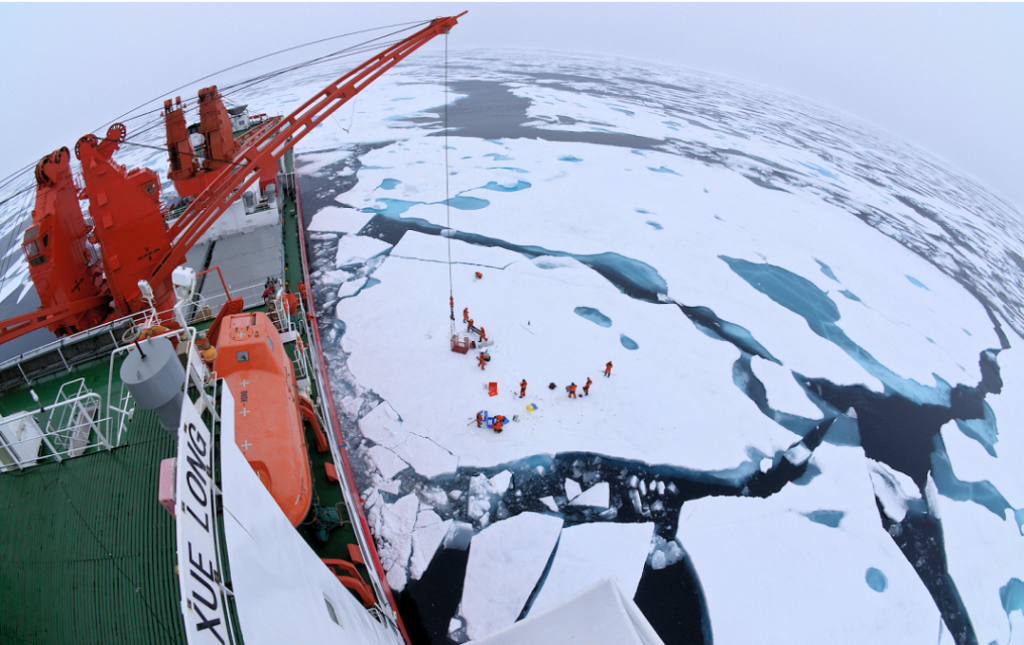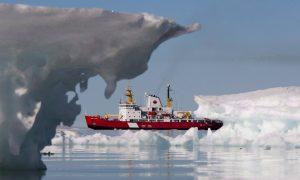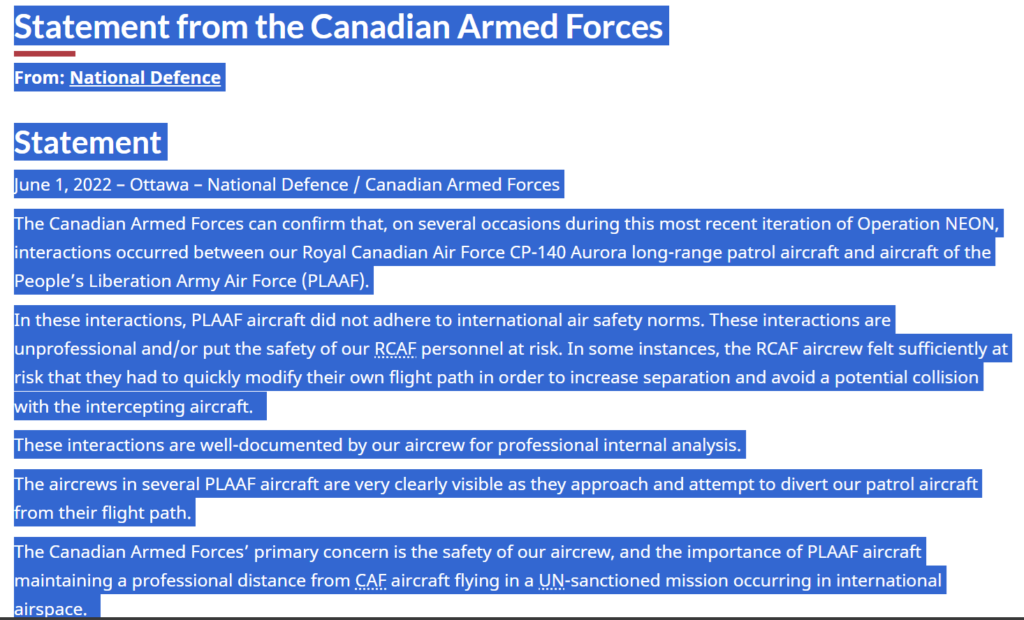Report via friends at thepochtimes.com. A Canadian warship was deployed to the Bering Strait in July to keep an eye on a Chinese polar research vessel as it navigated the passage between Russia and Alaska, underscoring Beijing’s growing interest in the region.

HMCS Regina in camouflage paint scheme used to confuse or obscure enemy’s visual observation.
The HMCS Regina shadowed the Chinese Research Vessel Xue Long 2 (China’s first domestically built Arctic research vessel) sometime between July 7 when it left its home port of Esquimalt, B.C., and July 25 when it returned.
China has called itself a “near-Arctic state” and has two icebreaking polar research vessels in service, the Xue Long and the Xue Long 2. The latter, delivered in 2019, has a displacement of 15,421 tons and is capable of breaking polar ice with both its bow and stern.

polarjournal.ch “On the scientific side, several research station and two Polar research vessel (here: Xue Long) underline China’s ambitions as an Arctic power. However, the plans of the Chinese government go far beyond research and science as outlined in the White Paper presented in 2018.” Image: Timo Palo- Own work, CC By-SA 3.0, via Wikicommons
Although the federal government did not publicize this part of HMCS Regina’s trip to the Arctic Ocean, a National Defence spokesperson confirmed the encounter in an email to The Epoch Times Aug. 1.
National Defence media relations officer Andrée-Anne Poulin also confirmed a Chinese People’s Liberation Army (PLA) naval task group was in the area.

cbc.ca : “The shadowing took place just days ahead of Foreign Affairs Minister Mélanie Joly’s surprise visit to China. The minister went to Beijing in an attempt to repair the frosty diplomatic relationship between Canada and China.”
“The ship and its embarked CH-148 Cyclone Air Detachment interacted safely and professionally with the Chinese Research Vessel Xue Long 2 throughout its transit through the Bering Strait,” Poulin said, adding that the Chinese task group vessels “remained in international waters at all times” and had “no encounters with HMCS Regina.”

canada.ca : “The CH-148 Cyclone is one of the most capable maritime helicopters in the world. It is Canada’s main ship-borne maritime helicopter, and it provides air support to the Royal Canadian Navy.”
National Defence declined to give further mission details, citing security protocol.


The U.S. Coast Guard reported the detection of Chinese navy vessels July 6 within the country’s exclusive economic zone that stretches 200 nautical miles from the coastline of Alaska.
The HMCS Regina left port in B.C. the following day. Commander of the Canadian navy’s Pacific fleet Dave Mazur said in a July 28 social media post the ship deployed “on short notice for a brief but impactful deployment.”
The U.S. Coast Guard said the Chinese vessels replied to radio communications, saying their purpose in the vicinity was “freedom of navigation operations.”
“The Chinese naval presence operated in accordance with international rules and norms,” Coast Guard District commander Megan Dean said in a July 10 press release. “We met presence with presence to ensure there were no disruptions to U.S. interests in the maritime environment around Alaska.”
The Coast Guard said it kept the Chinese task group under surveillance until all ships had crossed back into the Pacific Ocean.
Security Issues
The risk of foreign actors invading Canadian waters is on the rise as the region becomes more accessible, Poulin said.
Competitors are “exploring Arctic waters and the sea floor, probing our infrastructure and collecting intelligence,” she said. “We are seeing more Russian activity in our air approaches, and a growing number of Chinese dual-purpose research vessels and surveillance platforms collecting data about the Canadian North that is, by Chinese law, made available to China’s military.”
Despite not being an Arctic nation, China has aspirations of becoming a “polar great power” by 2030, according to the Canadian Security Intelligence Service (CSIS).
Poulin said China is increasingly growing its navy, including its nuclear-powered submarine fleet, as well as its investments, infrastructure and “industrial scientific influence throughout the Arctic region.”
Chinese encroachment in the Arctic is not a new issue. The country’s Snow Dragon icebreaker completed its first-ever voyage through Canada’s Northwest Passage in 2017.

A China Shipping Line cargo ship sails sails off the coast of Alaska past the Finnish icebreaker MSV Nordica on Tuesday, July 11, 2017. (David Goldman/The Associated Press)
China’s Xinhua News Agency described the voyage as one to test the viability of sailing Chinese cargo ships through the Arctic waterway that connects the Atlantic and Pacific oceans.
Joly Visit
Canada’s monitoring of the Chinese ships occurred when Foreign Affairs Minister Mélanie Joly was preparing for an official visit to China to reinforce bilateral ties.
The minister met with Chinese Foreign Affairs Minister Wang Yi on July 19 “to discuss Canada-China relations as well as complex global and regional security issues,” Global Affairs Canada said.
The meeting happened as there is heightened attention in Canada to Beijing’s interference in Canadian affairs, with an ongoing public inquiry investigating the issue.
Past Hostile Encounters
Beijing has also shown hostility to the Canadian military in other encounters.
Last year, a Canadian military helicopter operating in the South China Sea was buzzed by Chinese fighter jets, putting Canadian personnel at risk, the Department of National Defence (DND) said at the time.

A year before that, in international airspace in Asia, Chinese fighter jets also buzzed Canadian planes on a U.N. mission to support sanctions against North Korea.
A similar incident again happened in 2019, where Chinese jets buzzed Canadian ships in the East China Sea. For the Silo, Jennifer Cowan.
